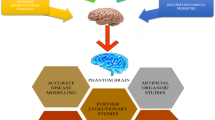Abstract
Human brain is a biological tissue, which weighs 1250–1600 gr, with a volume of 1130–1260 cm3, and it totally consists of about more than 2‧1010 neurons in average. It is considered as the most important part of the human body, which continuously functions during the whole human life. In this brief review, we will first present some minimal information about the fundamental knowledge of ellipsoidal geometry and the main equations that regulate the electric conductivity and permittivity in the brain tissues. Then, we will try to overview shortly the most basic information about the electrical conductivity in different parts of human brain and, mainly, the 4-ellipsoidal mathematical model concerning it. This seems to simulate and approximate better the shape and the electrical procedures that take place all over the volume of the brain than any other one so far.
Similar content being viewed by others
Author information
Authors and Affiliations
Corresponding author
Editor information
Editors and Affiliations
Rights and permissions
Copyright information
© 2022 Springer Nature Switzerland AG
About this entry
Cite this entry
Perakis, E. (2022). Brain Computational Models. In: Vlamos, P., Kotsireas, I.S., Tarnanas, I. (eds) Handbook of Computational Neurodegeneration. Springer, Cham. https://doi.org/10.1007/978-3-319-75479-6_48-1
Download citation
DOI: https://doi.org/10.1007/978-3-319-75479-6_48-1
Received:
Accepted:
Published:
Publisher Name: Springer, Cham
Print ISBN: 978-3-319-75479-6
Online ISBN: 978-3-319-75479-6
eBook Packages: Springer Reference Biomedicine and Life SciencesReference Module Biomedical and Life Sciences




